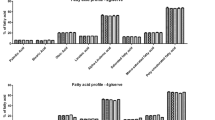Abstract
Fish oil is a rich source of omega 3 fatty acids, an essential fatty acid, vital for the functioning of the human body. But the undesirable flavour is an inherent limitation of fish oil which reduces its acceptability. Masking its fish flavour can increase acceptability of fish oil. The present study was focused on double encapsulation of fish oil to mask its distinct flavour. Fish oil was emulsified using soya lecithin where emulsifier to fat ratio was kept 1:4. The emulsion droplets were in the size range of 172.9 ± 1.7 to 238.2 ± 33.8 nm. The emulsion was mixed with whey protein—sodium alginate solution and converted to beads by dropwise extrusion in calcium chloride solution. Droplets were converted to soft gel beads containing fish oil. The encapsulation efficiency was 89.3%. Fish oil flavour was perceived from the dried beads. Hence, beads were further coated with high melting fat using pan coater and flavoured for making beads palatable to use as an oral supplement. Beads were free-flowing and light yellowish in colour. Beads coated with high melting fat and vanilla flavour scored more in the sensory evaluation by panelists. Beads were kept in airtight pack and stored under refrigeration.
Similar content being viewed by others
References
Chen LY, Subirade M (2006) Alginate–whey protein granular microspheres as oral delivery vehicles for bioactive compounds. Biomaterials 27:4646–4654
Chen LY, Subirade M (2007) Effect of preparation conditions on the nutrient release properties of alginate–whey protein granular microspheres. Eur J Pharm Biopharm 65:354–362
Chen Q, McGillivray D, Wen J, Zhong F, Quek SY (2013) Co-encapsulation of fish oil with phytosterol esters and limonene by milk proteins. J Food Eng 117:505–512
Floury J, Desrumaux A, Lardieres J (2000) Effect of high-pressure homogenization on droplet size distributions and rheological properties of model oil-in-water emulsions. Innov Food Sci Emerg Technol 1:127–134
Hansen LT, Annan NT, Borza AD (2008) Encapsulation in alginate-coated gelatine microspheres improves survival of the probiotic Bifidobacterium adolescentis 15703T during exposure to simulated gastro-intestinal conditions. Food Res Int 41:184–193
Jafari SM, Assadpoor E, Bhandari B, He Y (2008) Nano-particle encapsulation of fish oil by spray drying. Food Res Int 41:172–183
Keogh MK, O’Kennedy BT (1999) Milk fat microencapsulation using whey proteins. Int Dairy J 9:657–663
Kikuchi A, Kawabuchi M, Watanabe A, Sugihara M, Sakurai Y, Okano T (1999) Effect of Ca2þ-alginate gel dissolution on release of dextran with different molecular weights. J Control Release 58:21–28
Klinkesorn U, Sophanodora P, Chinachoti P, McClements DJ, Decker EA (2005) Increasing the oxidative stability of liquid and dried tuna oil-in-water emulsions with electrostatic layer-by-layer deposition technology. J Agric Food Chem 53:4561–4566
Kralovec JA, Zhang S, Zhang W, Barrow CJ (2012) A review of the progress in enzymatic concentration and microencapsulation of omega-3 rich oil from fish and microbial sources. Food Chem 131:639–644
Lee PS, Yim SG, Choi Y, Ha TVA, Ko S (2012) Physiochemical properties and prolonged release behaviours of chitosan denatured β-lactoglobulin microcapsules for potential food applications. Food Chem 134:992–998
McClements DJ, Decker EA, Weiss J (2007) Emulsion based delivery systems for lipophilic bioactive components. J Food Sci 72:109–124
Qian C, McClements DJ (2011) Formation of nano-emulsions stabilized by model food-grade emulsifiers using high-pressure homogenization: factors affecting particle size. Food Hydrocoll 25:1000–1008
Santi PAD, Nelson DG (2001) Taste masking of phenolics using citrus flavors. Patent No. 6,235,267 (US5945088) U.S. Patent and Trademark Office. Washington, DC
Schmitt C, Turgeon SL (2011) Protein/polysaccharide complexes and coacervates in food systems. Adv Colloid Interface Sci 167:63–70
Shahidi F, Zhong Y (2010) Lipid oxidation and improving the oxidative stability. Chem Soc Rev 39:4067–4079
Sinchaipanid N, Junyaprasert V, Mitrevej A (2004) Application of hot-melt coating for controlled release of propranolol hydrochloride pellets. Powder Technol 141:203–209
Subirade M, Hebrard G, Hoffart V, Beyssac E, Cardot JM, Alric M (2010) Coated whey protein/alginate micro particles as oral controlled delivery systems for probiotic yeast. J Microencapsul 27:292–302
Tamjidi F, Shahedi M, Varshosaz J, Nasirpour A (2013) Nanostructured lipid carriers (NLC): a potential delivery system for bioactive food molecules. Innov Food Sci Emerg Technol 19:29–43
Tan CP, Nakajima M (2005) Beta-Carotene nano-dispersions: preparation, characterization and stability evaluation. Food Chem 92:661–671
Tcholakova S, Denkov ND, Sidzhakova D, Ivanov IB, Campbell B (2003) Interrelation between drop size and protein adsorption at various emulsification conditions. Langmuir 19:5640–5649
Tonon RV, Grosso CRF, Hubinger MD (2011) Influence of emulsion composition and inlet air temperature on the microencapsulation of flaxseed oil by spray drying. Food Res Int 44:282–289
Trotta M, Pattarino F, Ignoni T (2002) Stability of drug-carrier emulsions containing phosphatidylcholine mixtures. Eur J Pharm Biopharm 53:203–208
Wang R, Tian Z, Chen L (2011) A novel process for microencapsulation of fish oil with barley protein. Food Res Int 44:2735–2741
Wichchukit S, Oztop MH, McCarthy MJ, McCarthy KL (2013) Whey protein/alginate beads as carriers of a bioactive component. Food Hydrocoll 33:66–73
Xu J, Zhao W, Ning Y, Bashari M, Wu F, Chen H, Yang N, Jin Z, Xu B, Zhang L, Xu X (2013) Improved stability and controlled release of ω-3/ω-6 polyunsaturated fatty acids by spring dextrin encapsulation. Carbohydr Polym 92:1633–1640
Author information
Authors and Affiliations
Corresponding author
Rights and permissions
About this article
Cite this article
Rathod, G., Kairam, N. Preparation of omega 3 rich oral supplement using dairy and non-dairy based ingredients. J Food Sci Technol 55, 760–766 (2018). https://doi.org/10.1007/s13197-017-2988-7
Revised:
Accepted:
Published:
Issue Date:
DOI: https://doi.org/10.1007/s13197-017-2988-7




